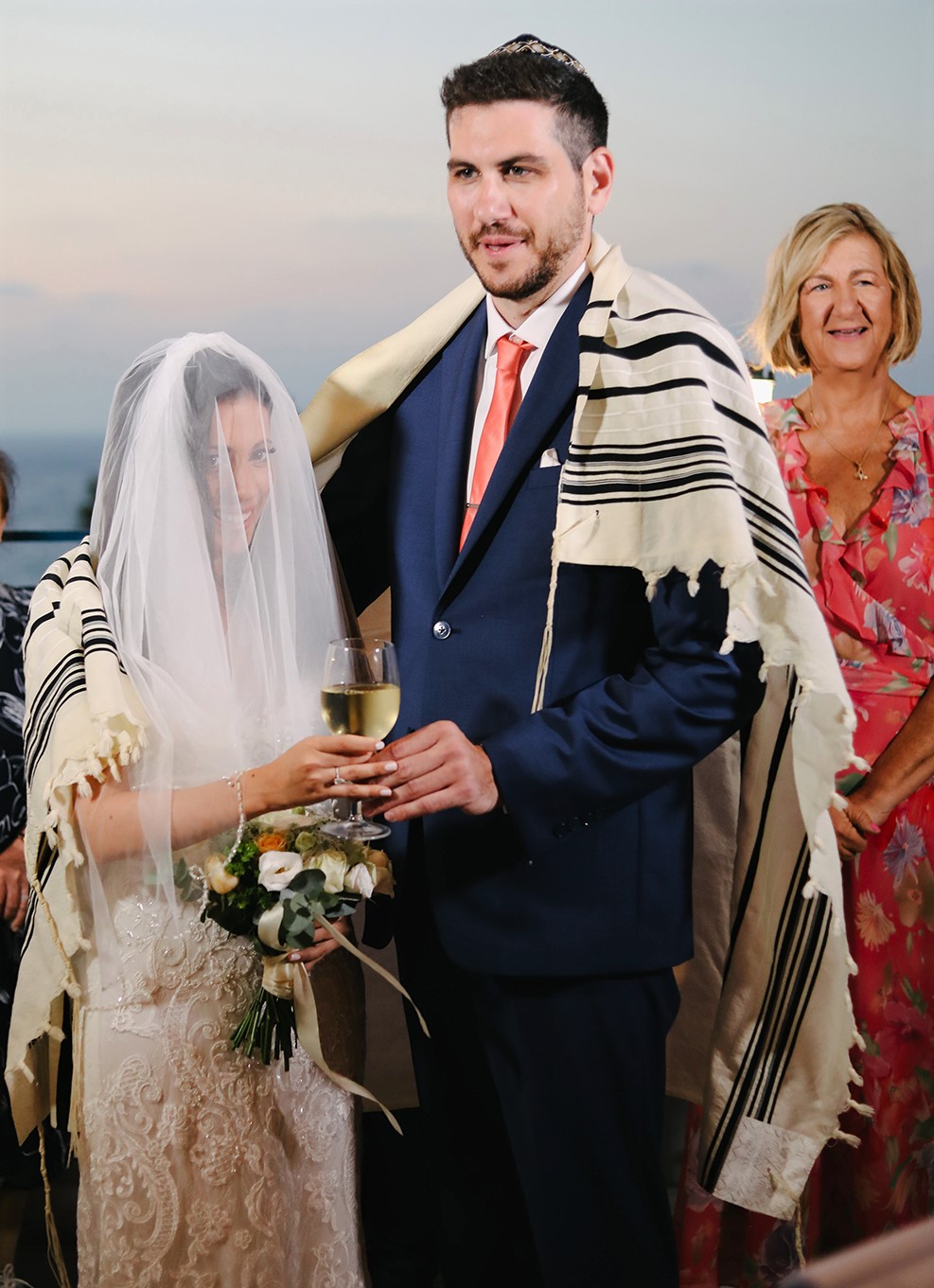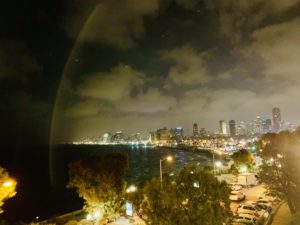 There is so much to tell about our trip to Israel it is hard to know where to start, so let’s just take things in the order that they happened so we don’t miss any important details.
There is so much to tell about our trip to Israel it is hard to know where to start, so let’s just take things in the order that they happened so we don’t miss any important details.
We arrived at the Tel Aviv airport and getting through customs and immigration was a breeze. This was Bonnie’s first time but George remembered a much more laborious process a few years ago. We grabbed a cab at the airport (we were told that the taxis upstairs offer a discount). UBER does not work here, there is an app called “Gett Taxi”, but it calls the same taxis as you hail on the street and adds a booking charge; you are better off just hailing one.
After a of bit of a mix up on the address for the Airbnb we managed to get settled in. It was a small but cute apartment with a loft bedroom (bath and shower upstairs). Downstairs was OK for George, but upstairs had exposed ceiling beams at about 5’10” (178 cm). We managed to make it through this trip with no serious injuries.
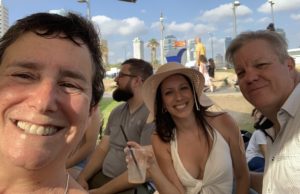 The whole reason we were in Israel is for the wedding of one of Bonnie’s Hansen students. We wanted to see Shelly (and Brian) as soon as possible so we decided to meet them at a beach bar a short walk from our place. Shelly was nice enough bring a box of wedding clothes (a suit for George, dress for Bonnie and nice shoes). Thanks again Becky for packing these up and getting them to us, we will send them back after the second wedding! After meeting the wedding couple and several of their friends, we wandered back to our place, hit the local supermarket and settled in for a quiet evening of dinner and Netflix at our flat.
The whole reason we were in Israel is for the wedding of one of Bonnie’s Hansen students. We wanted to see Shelly (and Brian) as soon as possible so we decided to meet them at a beach bar a short walk from our place. Shelly was nice enough bring a box of wedding clothes (a suit for George, dress for Bonnie and nice shoes). Thanks again Becky for packing these up and getting them to us, we will send them back after the second wedding! After meeting the wedding couple and several of their friends, we wandered back to our place, hit the local supermarket and settled in for a quiet evening of dinner and Netflix at our flat.
This would be a good time to mention the Lightening to HDMI adapter. For those of you who have an iPad or iPhone, this handy little adapter will allow you to stream anything you can watch on your apple mobile device onto the screen at your rental (assuming there is a HDMI input). Perfect for travelers, when you combine this with a VPN service and a HDMI cable, you are set for almost any hotel or rental that has a TV. Especially since most rental places do not have smart TVs.
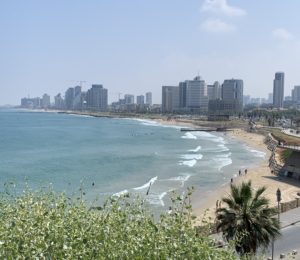
The next day (Saturday) was a free day for us, so we decided to walk along the amazing path that runs from the start of the beaches near Jaffa and works its way all the way down to the far end near the Hilton beach. One fun thing about this 6 mile walk (5K each way) is that the various beaches are all unofficially designated for different use groups. The first is a general use beach, followed by a family beach, then a beach to bring your dogs to play in the surf, followed by an ultra-religious beach and then finally a gay beach. Movement from one beach to another is casual and there is no real way to know you’ve moved from one to the other, except for the religious beach which is walled off and segregated.
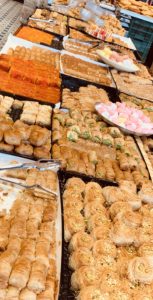 Sunday was the day for the big wedding. Since it was not until the evening, we started the day with a wander through Jaffa, this is a mostly Christian (with a lot of Muslim mixed in) section of Tel Aviv and the sidewalks are lined with shops selling food, sweets, clothing and everything in between.
Sunday was the day for the big wedding. Since it was not until the evening, we started the day with a wander through Jaffa, this is a mostly Christian (with a lot of Muslim mixed in) section of Tel Aviv and the sidewalks are lined with shops selling food, sweets, clothing and everything in between.
If you have never been to a Jewish wedding (we had one 35 years ago), then you should  make an effort to get invited to one. There is so much symbolism and pageantry to it. The bride and groom stand under a canopy, known as a chuppah (pronounced hoop-a); this represents the home that the couple will build together. The rabbi or cantor “sings” the most of the ceremony in Hebrew, with many of the phrases beginning with “Barukh ata Adonai Eloheniu”. The couple start out drinking wine from two glasses, then during the ceremony they drink together from the same glass. At the end of the ceremony the glass is wrapped in a cloth napkin* and the groom stomps it with the heal of his foot. The breaking of the glass symbolizes that no one else will drink from the cup they have shared. Upon the sound of the breaking glass the crowd shouts “Mazel Tov!” (which indicates a lucky thing has happened, in other words congratulations) and this typically kicks off a party. And a wonderful party it was: a delicious dinner, with lots of wine, with speeches and dancing afterword. While the whole event was relatively casual (not suits and ties for the guest); Shelly looked amazing in her wedding gown and Brian handsome in his suit!
make an effort to get invited to one. There is so much symbolism and pageantry to it. The bride and groom stand under a canopy, known as a chuppah (pronounced hoop-a); this represents the home that the couple will build together. The rabbi or cantor “sings” the most of the ceremony in Hebrew, with many of the phrases beginning with “Barukh ata Adonai Eloheniu”. The couple start out drinking wine from two glasses, then during the ceremony they drink together from the same glass. At the end of the ceremony the glass is wrapped in a cloth napkin* and the groom stomps it with the heal of his foot. The breaking of the glass symbolizes that no one else will drink from the cup they have shared. Upon the sound of the breaking glass the crowd shouts “Mazel Tov!” (which indicates a lucky thing has happened, in other words congratulations) and this typically kicks off a party. And a wonderful party it was: a delicious dinner, with lots of wine, with speeches and dancing afterword. While the whole event was relatively casual (not suits and ties for the guest); Shelly looked amazing in her wedding gown and Brian handsome in his suit!
(*Spoiler: in modern day weddings, a glass light bulb is slipped in to replace the glass. This leads to fewer trips to the hospital from cut feet and the bulb makes a much better popping sound when it breaks…)
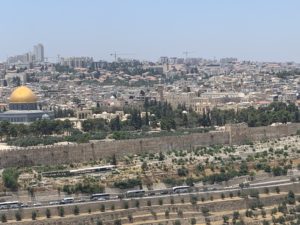 The day after the wedding the family was kind enough to invite us for a us for a guided tour of Jerusalem. Your religion (of lack thereof) doesn’t matter. There is enough history and culture here to overwhelm almost
The day after the wedding the family was kind enough to invite us for a us for a guided tour of Jerusalem. Your religion (of lack thereof) doesn’t matter. There is enough history and culture here to overwhelm almost  anyone. We started at the Mount of Olives and looked out over the old city. There is a huge graveyard just outside the walls of the city. The Jews believe that when the messiah comes to earth he will walk though of the gates into the old city and the dead everywhere will rise and follow him into eternal life. So religious folks spend a small fortune to be buried close to the gate with their feet facing the old city. This makes it some of the most expensive real estate in the world.
anyone. We started at the Mount of Olives and looked out over the old city. There is a huge graveyard just outside the walls of the city. The Jews believe that when the messiah comes to earth he will walk though of the gates into the old city and the dead everywhere will rise and follow him into eternal life. So religious folks spend a small fortune to be buried close to the gate with their feet facing the old city. This makes it some of the most expensive real estate in the world.
Inside of the walls, the city is divided into four quadrants (or Quarters) these include the Christen Quarter, The Jewish Quarter, The Muslim Quarter and the Armenian Quarter. Each group considers their part of the old city to be hugely important, if not central, to their religion. Each 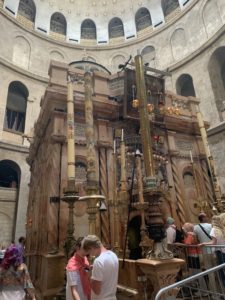 Quarter with the exception of the Armenian area is open to the public. The Christian Quarter houses the Church of the
Quarter with the exception of the Armenian area is open to the public. The Christian Quarter houses the Church of the 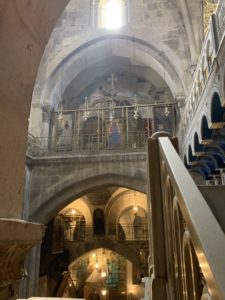 Holy Sepulcher and is built at the location of Calgary (or Golgatha) where Christians believe Jesus was crucified. It is possible to kneel at an alter at the top of the church, stick your hand through a hole in the floor and touch the top of the Calgary stone, and on the ground floor there is a slab of marble that is said to be the final resting place of Christ’s body. Deep inside the church you can see the tomb of Jesus along with many other sacred relics.
Holy Sepulcher and is built at the location of Calgary (or Golgatha) where Christians believe Jesus was crucified. It is possible to kneel at an alter at the top of the church, stick your hand through a hole in the floor and touch the top of the Calgary stone, and on the ground floor there is a slab of marble that is said to be the final resting place of Christ’s body. Deep inside the church you can see the tomb of Jesus along with many other sacred relics.
One of the most important points of the Jewish sector is the “Wailing Wall” (or Western Wall), which is not technically part of the wall around the city, but it is physically as close as the Jewish people can get the Temple Mount. People come from around the world to pray at this extremely sacred place. Access to the wall is 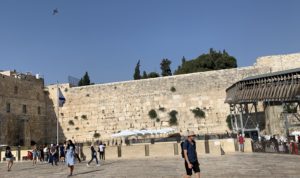 segregated so after a ceremonial washing of hands men and women approach the wall in separate areas. A common custom here is to write a prayer or wish onto a small scrap of paper and wedge the paper into the cracks of the wall.
segregated so after a ceremonial washing of hands men and women approach the wall in separate areas. A common custom here is to write a prayer or wish onto a small scrap of paper and wedge the paper into the cracks of the wall.
We got home from Jerusalem tired but thrilled with our day grabbed a pizza and relaxed. The next day we headed back to the Jaffa in search of the best Shawarma, which is typically made with roast lamb sauces and lettuce wrapped in a pita. We found an excellent one and washed it down with a cold Israeli beer.
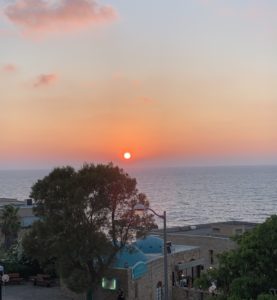 All too soon out trip to Tel Aviv was over, but we get to look forward to another wedding for another Hansen student…off to Romania!
All too soon out trip to Tel Aviv was over, but we get to look forward to another wedding for another Hansen student…off to Romania!


